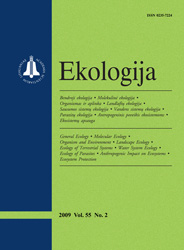 ISSN 0235-7224 ISSN 2029-0586 (online) |
2007 m. Nr. 1 Remediation of landfill soils with sewage sludge.
2. Microarthropod communities in the soil formation
process
Remediation of buried and destroyed soils is one of the most relevant ways to preserve terrestrial ecosystems. Application of sewage sludge for landfill remediation is a good solution of two problems: sewage sludge utilization and landfill remediation. However, it should be borne in mind that the intensity of soil formation directly depends on the amount of introduced organics and pedobiont activity. Investigations revealed that after nine years of remediation with sewage sludge, landfill soils contain up to 6.0% of humus and are most highly polluted with zinc (360.5 mg/kg) and chromium (106.0 mg/kg). In the mentioned time span, the concentrations of most heavy metals reduce to 2.4 times. The concentrations of heavy metals during landfill remediation with sewage sludge do not inhibit microarthropod successions in the soil. A certain equilibrium sets among the microarthropod groups, though euribiont species (Tectocepheus velatus, Isotoma notabilis, Mesophorura gr. armata) are dominant. Landfill soil and grass are most highly polluted with zinc. Zinc is also the main pollutant accumulated by grasses in the peripheral part of a landfill. Keywords: landfill, peripheries, heavy metals, microarthropods, sewage sludge |
Issues:
2011 - Vol.57 No. 1, No. 2 2010 - Vol.56 No. 1-2, No. 3-4 2009 - Vol.55 No. 1, No. 2, No. 3-4 2008 - Vol.54 No. 1, No. 2, No. 3, No. 4 2007 - Vol.53 No. 1, No. 2, No. 2.priedas, No. 3, No. 4 2006 No. 1, No. 2, No. 3, No. 4 2005 No. 1, No. 2, No. 3, No. 4 2004 No. 1, No. 2, No. 3, No. 4 2003 No. 1, No. 2, No. 3, No. 4 2002 No. 1, No. 2, No. 3, No. 4 2001 No. 1, No. 2, No. 3, No. 4 |